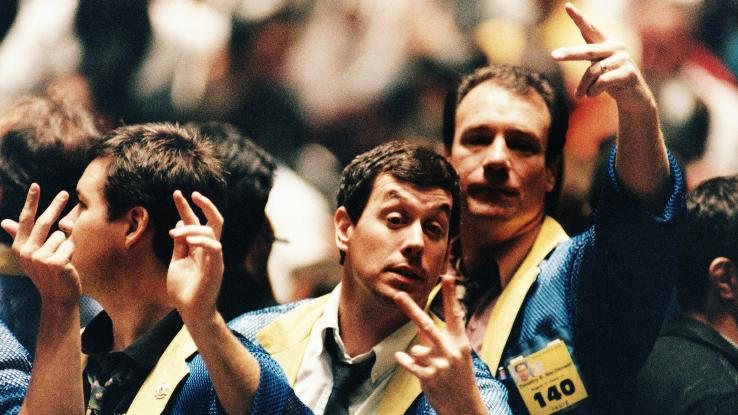A Is a Company That Owns Most of Its Market Share and Can Set Its Own Price.

It doesn't take long before beginning investors are hitting with market place lingo similar "market toll per share" and "book toll per share." But what practice these terms actually mean, how are they different, and why should you intendance? Bring together us as we break down the meanings of both, tell you how to determine them, and how they can be useful information for you lot as an investor to go along in mind.

Simply put, a stock's market price per share is the price that appears whenever you click on its ticker. If the stock is experiencing a day of heavy volume, the marketplace price per share may literally change by the 2nd every bit the price fluctuates up and down.
That'due south because the market price per share is all about supply and demand. In essence, it'southward the price that the stock is trading for at any given moment. The more people who are interested in buying the stock, the more its going rate will climb. When there are more than investors interested in selling their shares than there are those interested in buying them, the price will get down.
Several things can cause a certain company'due south stock price to move including:
- Things similar a great earnings study, a hot new product, a recently approved drug, or a promising new CEO tin can cause more than interest in the company. As more than investors buy shares, the stock market'due south toll per share can get up.
- Likewise, bad news tin cause a stock'south market place price per share to nosedive. An unflattering earnings report, a scandal, or a simple lack of interest in the visitor's products or services can cause sellers to attempt to unload their shares en masse, which drives the cost down.
- When it comes to meme stocks or twenty-four hours trading "stocks in play," a stock's market price per share may experience large price fluctuations simply due to volume solitary. In these instances, company fundamentals don't tend to matter and then much, as the stock price moves merely because a large number of people are trading information technology at once.
How Is Market place Price Per Share Determined?

Equally we mentioned in a higher place, the marketplace cost per share is all about supply and demand, which is ultimately what causes it to move either up or down. When you're trading on a web-based platform, it's like shooting fish in a barrel to forget that yous're actually more than or less participating in an online auction for shares of unlike companies.
On ane side, some people own the shares but are willing to sell them for the right cost. That price is called the "ask." On the other, some sellers are looking to buy the shares. The buyers place "bids" on the shares, which is basically a way of saying they'll purchase them for a certain price and not a penny more.
The market price per share is the magical moment when a buyer's bid price and a seller's enquire price align and a auction is generated. Equally with whatever other product, when there'south more demand than supplies, prices will be higher. When in that location's more supply than demand, prices will exist cheaper.
How to Apply Marketplace Price Per Share to Summate Market place Cap

Desire to know the value of a company you're considering investing in? You tin can use the current market price per share to calculate something called a company'southward market capitalization or "market place cap." This will tell yous what the visitor's overall value is on the stock marketplace and its perceived value every bit far as investors are concerned.
A visitor's market cost per share refers to the total value of all of the company's outstanding shares put together. Outstanding shares are the shares that the company has authorized to be traded on the stock marketplace and which are held by investors. Outstanding shares are opposed to treasury shares, which are shares still held by the company itself.
To calculate a company's market cap, merely multiply the electric current market price per share past the number of full shares outstanding. This volition tell you how much the company is ultimately worth on the market.
Market place Price Per Share Example

Using a company's market cost per share to decide its market cap volition allow you to understand the size of ane company as compared to others, as well as its value on the market at large. For example, let'south say that Visitor A had a market price per share of $10, while Visitor B's were currently selling for $v. Y'all might initially assume that Visitor A had the higher market place cap, right? Not so fast!
Say, upon further examination that you lot discovered that Company A had a total of 10 1000000 outstanding shares. You could calculate their market place cap like so:
$10 x 10 1000000 = a full market place cap of $100,000,000
Not too shabby. Merely let's say that you then discovered that Company B had a total of 100 million outstanding shares and used the same formula.
$v x 100,000,000 = a full market cap of $500,000,000
Ultimately, in the market's eyes, Visitor B is actually the more than valuable of the two.
Marketplace Price Per Share Vs Book Value Per Share

Market price per share is sometimes compared to a visitor's book value per share, but what is the deviation? While the market price per share reflects the current toll that shares are selling for, volume value per share takes a visitor's net worth into account.
To decide volume value per share you would start with the company'southward total avails and and then subtract their liabilities. Liabilities can include things like debt, overhead, and supplies, etc. The difference betwixt the two reflects what the company is actually worth.
Say, for instance, that Company C'south total assets were $100 1000000, merely they were besides $xl million in debt. So their net value would be $60 million. Once you go far at that figure, you'd divide information technology past the number of Company C's shares outstanding. Let's say in this case that they had ten million outstanding shares. So:
$lx,000,000/ x million= a volume value per share of $6
Why does this matter? Because comparing a company's book value per share to their current market value per share can be a swell way to find growth opportunities. For instance, if visitor C was currently trading at a market place price per share of $ii.00, information technology could exist a sign that the company is undervalued and that the current price is a good buy. On the other paw, if Company C's shares were currently trading for $12 per share, you might be a bit more wary because they could be overvalued and destined to correct.
curtismostanquest.blogspot.com
Source: https://www.askmoney.com/investing/calculate-market-price-per-share?utm_content=params%3Ao%3D1465803%26ad%3DdirN%26qo%3DserpIndex
0 Response to "A Is a Company That Owns Most of Its Market Share and Can Set Its Own Price."
Post a Comment